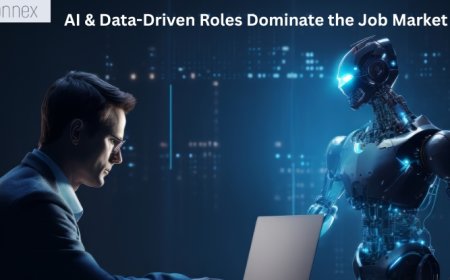AI and Machine Learning: Future Trends and Career Insights
Explore AI and Machine Learning development trends, applications, and career opportunities. Learn how AI is transforming industries and shaping the future.

Introduction
Artificial Intelligence (AI) and Machine Learning (ML) have emerged as transformative technologies, redefining industries and revolutionizing how we live and work. From self-driving cars to voice assistants and predictive analytics, AI and ML are powering innovations that were once considered science fiction. This blog explores the growth, applications, and career opportunities in AI and ML development.
What is AI and Machine Learning?
-
Artificial Intelligence (AI): The simulation of human intelligence in machines, enabling them to perform tasks such as problem-solving, decision-making, and language processing.
-
Machine Learning (ML): A subset of AI that trains machines to learn from data without explicit programming, allowing them to improve over time.
Key Difference: AI is the broader concept of machines simulating intelligence, while ML focuses on data-driven learning and pattern recognition.
The Growing Impact of AI and ML
AI and ML are reshaping various industries, making them more efficient, data-driven, and automated.
-
Healthcare:
-
AI-assisted diagnostics (X-rays, MRIs).
-
Predictive models for disease prevention.
-
Personalized medicine using ML algorithms.
-
-
Finance:
-
Fraud detection with AI-powered analysis.
-
Automated trading and financial forecasting.
-
Customer support chatbots.
-
-
Retail & E-commerce:
-
AI-driven product recommendations.
-
Automated inventory management.
-
Personalized marketing campaigns.
-
-
Transportation:
-
Self-driving vehicles powered by AI.
-
AI-based traffic management systems.
-
Predictive maintenance of vehicles.
-
-
Education:
-
Adaptive learning platforms.
-
AI-powered virtual tutors.
-
Personalized learning experiences.
-
AI and ML are expected to contribute $15.7 trillion to the global economy by 2030, according to PwC.
Key Technologies in AI and ML Development
To build AI and ML solutions, developers rely on cutting-edge technologies and frameworks:
-
Programming Languages:
-
Python (most popular for ML).
-
R (statistical computing).
-
Java and C++ (for performance-intensive tasks).
-
-
ML Frameworks:
-
TensorFlow (Google): Open-source platform for ML and deep learning.
-
PyTorch (Meta): Used for neural networks and advanced ML models.
-
Scikit-Learn: Python-based library for basic ML tasks.
-
-
Data Visualization Tools:
-
Tableau, Power BI, and Matplotlib for data interpretation.
-
-
Cloud Platforms:
-
AWS, Google Cloud AI, and Microsoft Azure ML for AI deployment and scalability.
-
Applications of AI and ML Development
AI and ML are driving innovative solutions across multiple sectors:
1. Natural Language Processing (NLP)
-
AI-powered language models like ChatGPT and Bard process and generate human language.
-
Applications:
-
Automated content generation.
-
Sentiment analysis for social media.
-
AI-based translation services.
-
2. Computer Vision
-
ML algorithms process images and videos for identification and interpretation.
-
Applications:
-
Facial recognition systems.
-
Autonomous vehicle navigation.
-
Medical image analysis.
-
3. AI-Powered Automation
-
Automating repetitive tasks using AI and ML models.
-
Applications:
-
Chatbots for customer service.
-
Robotic Process Automation (RPA).
-
Predictive maintenance in manufacturing.
-
4. Fraud Detection and Cybersecurity
-
AI-driven models detect suspicious activity and prevent fraud.
-
Applications:
-
Credit card fraud detection.
-
Real-time threat analysis.
-
Cybersecurity monitoring.
-
Career Opportunities in AI and ML Development
AI and ML development offers lucrative career paths with high demand for skilled professionals:
-
AI Engineer:
-
Develops and deploys AI models.
-
Skills: Python, TensorFlow, NLP, and data science.
-
Average Salary: ₹12-25 LPA in India, $110K-$160K in the US.
-
-
Machine Learning Engineer:
-
Builds and trains ML algorithms.
-
Skills: Python, ML frameworks, and deep learning.
-
Average Salary: ₹10-20 LPA in India, $100K-$150K in the US.
-
-
Data Scientist:
-
Analyzes complex data using AI and ML.
-
Skills: Python, R, data visualization, and ML models.
-
Average Salary: ₹8-18 LPA in India, $90K-$140K in the US.
-
-
AI Research Scientist:
-
Works on cutting-edge AI innovations and research.
-
Skills: Deep learning, NLP, and AI frameworks.
-
Average Salary: ₹15-30 LPA in India, $120K-$180K in the US.
-
Skills Required for AI and ML Development
To succeed in AI and ML development, you need a strong technical skill set:
-
Programming Skills: Python, R, and Java.
-
Mathematics and Statistics: Linear algebra, probability, and calculus.
-
Data Manipulation: Pandas, NumPy, and SQL.
-
Model Deployment: AWS, Google Cloud, and Docker.
-
Problem-Solving: Analytical thinking and creativity.
The Future of AI and ML
The AI and ML industry is set to experience exponential growth with new innovations:
-
Explainable AI (XAI): AI models with enhanced transparency and interpretability.
-
Edge AI: AI processing on devices instead of cloud servers, boosting efficiency.
-
Generative AI: AI-created content, including text, images, and videos.
-
AI in Metaverse: Enhanced virtual reality experiences with AI-powered avatars.
By 2030, AI is expected to create over 70 million new jobs globally, according to the World Economic Forum.
Conclusion
AI and ML development are transforming the tech landscape by enabling smarter, faster, and more efficient systems. With applications across industries and a growing demand for skilled professionals, a career in AI and ML offers exciting opportunities and lucrative growth potential.































































































